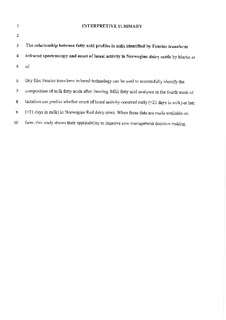| dc.description.abstract | To investigate the feasibility of milk fatty acids as predictors of onset of luteal activity (OLA), 87 lactations taken from 73 healthy Norwegian Red cattle were surveyed over 2 winter housing seasons. The feasibility of using frozen milk samples for dry-film Fourier transform infrared (FTIR) determination of milk samples was also tested. Morning milk samples were collected thrice weekly (Monday, Wednesday, Friday) for the first 10 wk in milk (WIM). These samples had bronopol (2-bromo-2-nitropropane-1,3-diol) added to them before being frozen at −20°C, thawed, and analyzed by ELISA to determine progesterone concentration and the concentrations of the milk fatty acids C4:0, C14:0, C16:0, C18:0, and cis-9 C18:1 as a proportion of total milk fatty acid content using dry-film FTIR, and averaged by WIM. Onset of luteal activity was defined as the first day that milk progesterone concentrations were >3 ng/mL for 2 successive measurements; the study population was categorized as early (n = 47) or late (n = 40) OLA, using the median value of 21 DIM as the cutoff. Further milk samples were collected 6 times weekly, from morning and afternoon milkings, these were pooled by WIM, and one proportional sample was analyzed fresh for fat, protein, and lactose content by the dairy company Tine SA, using traditional FTIR spectrography in the wet phase of milk. Daily energy-balance calculations were performed in 42 lactations and averaged by WIM. Animals experiencing late OLA had a more negative energy balance in WIM 1, 3, 4, and 5, with the greatest differences been seen in WIM 3 and 4. A higher proportion of the fatty acids were medium chained, C14:0 and C16:0, in the early than in the late OLA group from WIM 1. In WIM 4, the proportion of total fatty acid content that was C16:0 predicted late OLA, with 74% sensitivity and 80% specificity. The long-chain proportion of the fatty acids C18:0 and cis-9 C18:1 were lower in the early than in the late OLA group. Differences were greatest in WIM 4 and 5. Differences in concentrations of cis-9 C18:1 were seen between the groups from WIM 1. No relationship was seen between OLA and milk concentrations of either protein or fat, or between OLA and the milk fat:protein ratio. The differences in milk fatty acid proportions between the 2 groups are most likely related to differences in energy balance. The study shows that frozen milk samples can be tested for fatty acids by FTIR spectroscopy and that FTIR spectroscopy of milk can be used to provide real-time information about cow reproductive function. | |
